Archive for the ‘Uncategorized’ Category
How To Clean Hardwood Floors

1. Sweep Or Vacuum Hardwood Floors
The first step in cleaning your hardwood floors will be sweeping or vacuuming. You must clear your floors of crumbs, dust, and dirt. Traditionally, sweeping would be the best way to clean up the debris from your hardwood floors. However, there now are many vacuums with soft bristle brushes that can begin the cleaning process quicker and more efficiently than sweeping.
2. Mop Hardwood Floors
Next, you must clean up any grime, gunk, or mess that can’t be swept or vacuumed. You will need a microfiber mop and floor cleaner designed for hardwoods. Gently dampen your mop, being sure not to oversaturate your floors. Too much liquid can be damaging to your floors. Make sure you mop along the wood grain for the deepest clean.
3. Revitalize Your Floors
Even the most careful homeowners will accumulate scratches and scuffs on their hardwood floors over time. Once your hardwood floors have been swept and mopped, you can better understand your floors’ actual condition. At this point, using a liquid scratch concealer and floor polish can really make your floors pop. There are tons of great products out there; be sure to buy something that matches the color of the stain that your hardwoods were finished with.
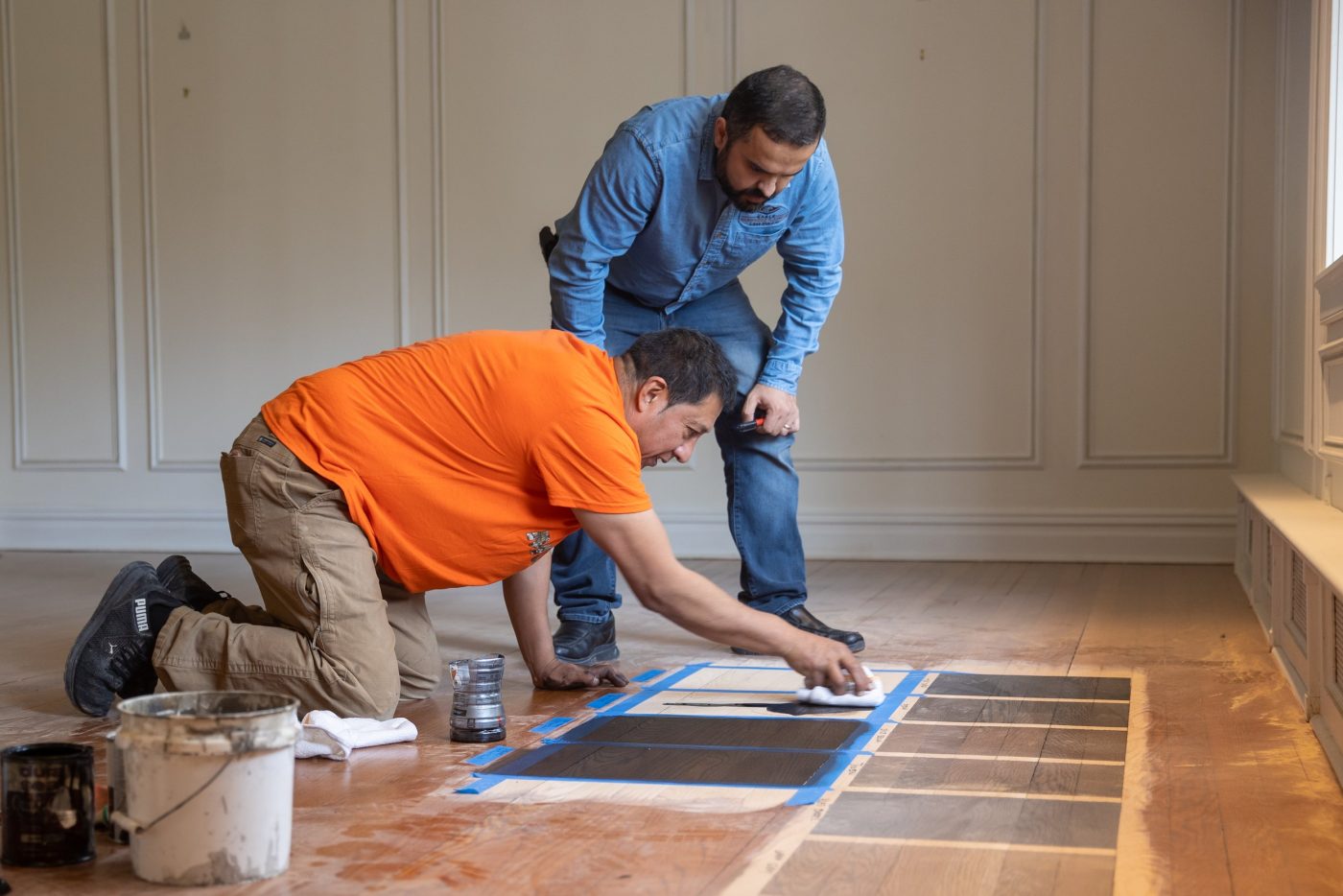
4. Maintain Your Floors
This might seem like an obvious suggestion, but keeping on top of keeping your floors clean, will keep them healthier and ultimately last much longer. Avoid only doing deep cleans when your floors get filthy. Dirty floors that need attention will need serious work much sooner and more frequently than happy and clean floors!
5. Protect Hardwood Floors
Hardwood floors are designed to last a lifetime when properly maintained. However, all homes have unique and specific needs to keep their floors in good shape. Do you have pets that could scratch and stain your floors? Check out this article on how to keep your floors safe from dog-related issues. Do you have children that are rough on your floors? Consider using large area rugs where most of their play happens. Are there areas of your home that see a lot of foot traffic? Be sure to properly use runners and floor mats to keep unnecessary wear and tear to a minimum. The list can go on and on, but all the time and effort you give to protecting your hardwood floors will pay off in the end!
If you are in New York or Florida, we would love to help you choose the best hardwood flooring!
What Hardwood Flooring Is The Best?
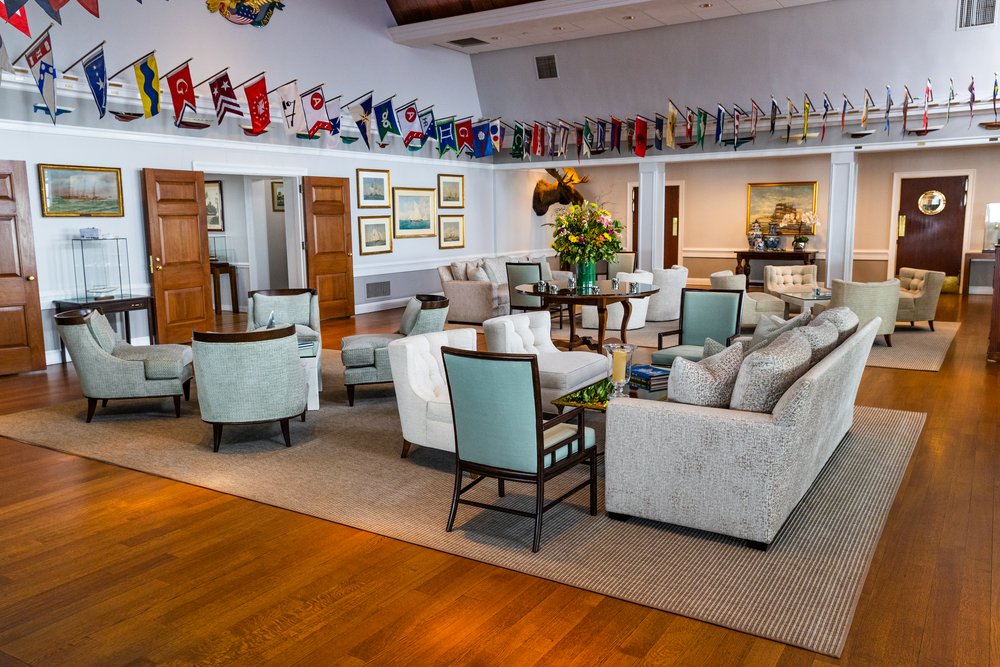
The best hardwood floors for most people will be Oak floors, stained and then finished with polyurethane
Starting from scratch and figuring out what kind of hardwood floors are best can be daunting. There are many different species of hardwood for floors. There are also multiple configurations of how the floors can be manufactured. On top of that, there are even more choices regarding the finishing you want on the floors. Let’s start with a budget.
Budget
If your budget allows, we advise choosing traditional hardwood planks. They are the most durable and easiest to fix and repair if there ever were to be a need. They also will last the longest if properly maintained. If hardwood planks aren’t an option, there are many great engineered hardwood products that are indistinguishable from traditional hardwood. They have a thin layer of hardwood on top of a plank made mostly of pressed wood. This keeps their cost a little lower. If budget is really an issue, the amount of quality vinyl floor options is remarkable.
Appearance
When it comes to appearance, this is a very subjective issue. However, we have found that the image that comes to mind when most people imagine buying hardwood floors for their home, they are thinking of Oak floors. Oak is by far the most popular choice for hardwood floors. It makes up roughly two-thirds of all hardwood floors in America. With all hardwood floors, Oak can be stained, giving the same cut of hardwood many different shades of color. Other popular wood species are maple and cherry, which both have very distinct qualities.

Hardness
Not all wood species are created equal when it comes to hardness. There are some wide discrepancies regarding the different species of wood. Depending on the type of traffic and use of the floors should impact your wood selection. Here’s a quick chart of the most common species of hardwood, listed by their Janka rating. The Janka rating is how the different species’ hardness is measured.
Availability
Most of the more common hardwood species are readily available from Hardwood distributors and big-box stores. However, some species of less common hardwoods and softwoods might be harder to source. This could cause the project timelines and even the budget to go up. We suggest asking these types of questions with your contractor before falling too much in love with a species of wood that could be hard to source.
Personal Taste
Everyone is different! A new set of hardwood floors can bring some serious character into a house. But they also can give a home a calm and muted feel. There is no right or wrong answer regarding what will be right for you. We suggest talking to a bonded and licensed flooring specialist early in your process to have the most accurate information.
If you are in New York or Florida, we would love to help you choose the best hardwood flooring!
When Are Hardwood Floors Beyond Repair?
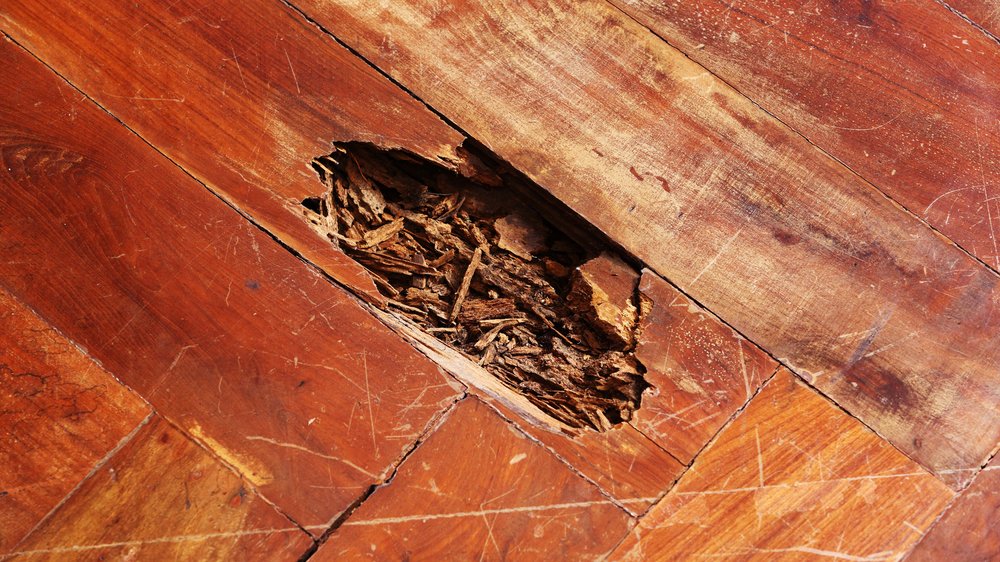
Are your hardwood floors repairable, or do they need to be replaced? As hardwood flooring experts in New York and now Florida, we have years of experience helping people determine a proper course of action when repairing their hardwood floors. Hardwood floors are designed to be solid and durable. However, they can reach the point where they are beyond repair and must be replaced. Here are the most common instances where hardwood floors are beyond repair.
Termites
As we discussed in a previous article, termites can be big trouble for hardwood floors. However, not all termite damage means a complete replacement for your hardwood floors. If the damage is superficial and not extensive, or, if termites only damaged certain parts or planks of hardwood, they could be repaired. Most of the time, when termites attack a hardwood floor, they usually will need to be replaced. A licensed hardwood flooring expert can help you determine the best course of action regarding termites.
Cracked And Broken Wood
Hardwood floors are expected to shrink and expand throughout the calendar year. In seasons of heat and moisture, your floors will expand. In the winter, they will shrink. Shifts in the size of the cracks between the planks do not necessarily indicate anything is wrong. However, cracks and splits in the boards usually suggest that a part of the floor will need to be replaced. Some small cracks and breaks can be glued back together, but most large splits in a particular board will require replacing it.
Cupped And Buckling Planks
Hardwood floors react severely to different humidity levels in their environments. In homes and homes with excess moisture or an extreme lack of humidity, weird things can begin to happen. Cupping and buckling are when the individual hardwood planks begin to burl and buckle due to their environment. The first step to take when you notice something like this is happening is to bring the humidity level of the hardwoods back to a normal level. Sometimes, the wood will flatten back out. However, planks will generally need to be replaced if cupping or buckling gets too bad. We suggest giving someone like us a call as soon as you notice your hardwood floors beginning to take on an unnatural shape. Getting the issue corrected quickly and effectively can save you time and money.
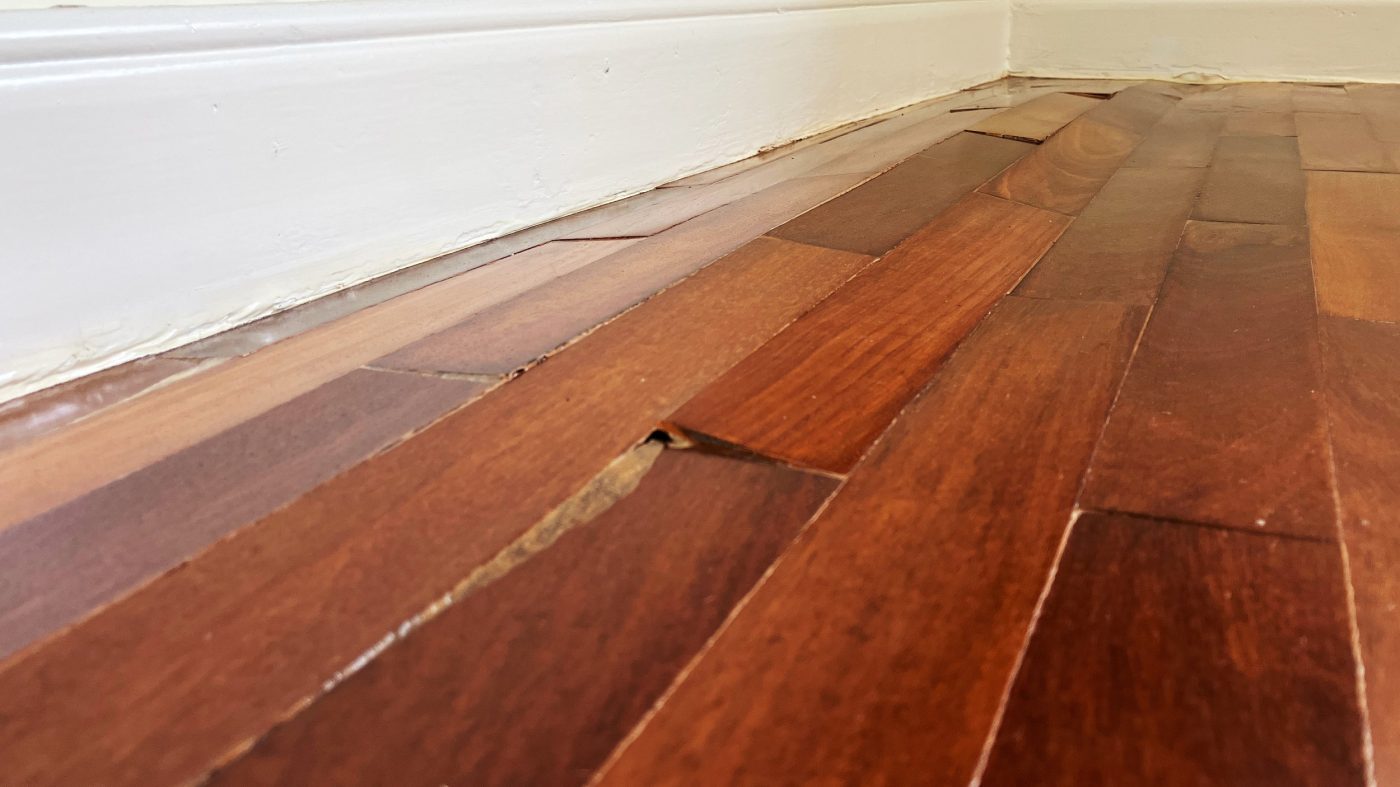
We Are Here To Help!
Most issues that would cause your hardwood floors to need to be replaced can be remedied if acted on quickly enough. Scheduling a consultation is free and could save you a ton of money and heartache. If you are in New York or Florida, please don’t hesitate to call with any of your hardwood flooring needs!
Are Hardwood Floors Expensive?

Are hardwood floors expensive? The cost and value of installing hardwood floors is a personal matter unique to each individual. However, we can compare the prices of hardwood floors to two other popular flooring options: carpet and vinyl.
Genuine Hardwood Floors
The current cost for hardwood floors is between $6-$18 per square foot. However, this price includes the cost of materials and labor costs to have them installed. The average cost for materials, which consists of the floors themselves, is between $3-$10 per square foot. There are more expensive types of hardwood floors, but $3-$10 is a good rule of thumb for current hardwood flooring prices. Genuine hardwood floors can be challenging to install, but possible. However, unlike other types of flooring, correctly installing genuine hardwood floors is crucial in maintaining their health and longevity. Cutting the labor cost or eliminating it is only a good idea if you have real experience with their installation.

Carpet
The current average cost for installing carpet is $5-$11 per square foot. This includes both materials and labor. In almost every case, installing carpet will be more affordable than hardwood floors. Carpet installation is more straightforward. Labor costs are less expensive than hardwood floors. We are seeing a resurgence in demand for carpet in individual rooms of many homes today. Even if you decided to only carpet certain rooms of your home, going with carpet would lower your expenses.
Vinyl Floors
Vinyl flooring falls between genuine hardwood and carpet for its price. With an average installation cost of between $5-$14, it is a common choice for people who want the look of hardwood floors but are trying to cut costs. There are many types of vinyl flooring at many price points. For example, luxury vinyl can become expensive, whereas peel-and-stick vinyl is cheaper than carpet. You should talk to a flooring specialist about your budget and expectations when considering using vinyl for floors.
Conclusion
Is hardwood flooring expensive? Yes and no. Genuine hardwood floors are usually the most expensive option for flooring. However, there are many reasons why genuine hardwood floors are the best long-term financial decision. Hardwood floors will almost always last the longest of all your floor options when adequately maintained. Hardwood floors are also one of the best ways to increase the value of a home or property, as they are still seen as being valuable by potential buyers.
If you are in New York or Florida and would like a free consultation about your next flooring project, we would love to help you!
Oil-Based Vs. Water-Based Polyurethane Finishes
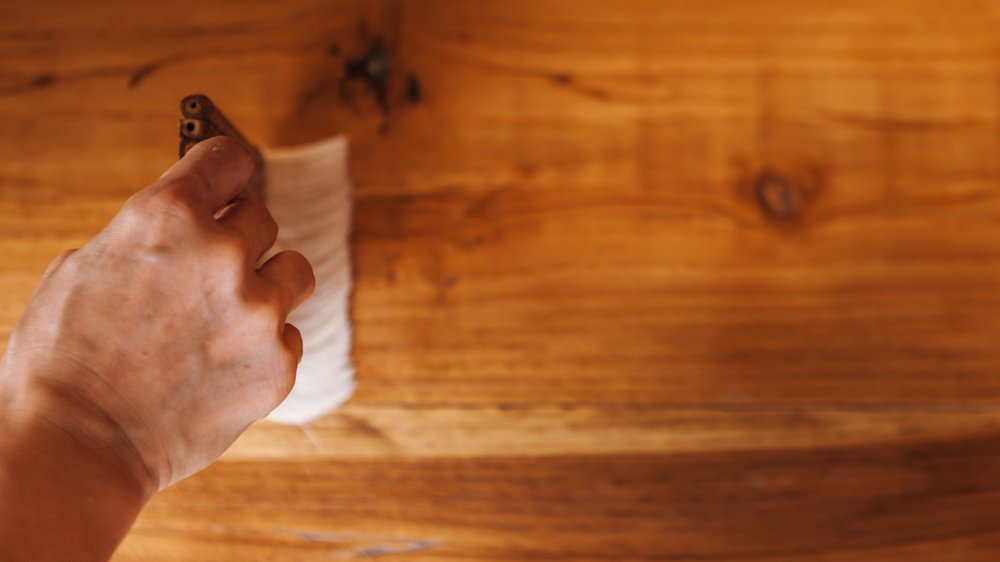
There are several aspects to consider when deciding between an oil-based polyurethane or a water-based polyurethane.
Appearance:
Oil-based poly will darken with an orange/yellow tint over time, while water-based poly will remain clear through its lifetime. This amber tint produced by oil-based poly is subtle when applied to a hardwood floor. However, it will still darken over time. Many prefer the “ambering” of oil-based polyurethane as it adds a rich depth charm. However, this is a personal preference.
Smells:
Fumes emitted during the curing time of oil-based poly are much more pungent than those of its water-based alternative that has little to no smell while used. When using and curing oil-based poly, proper breathing equipment is recommended until the area is dry and adequately ventilated. Vacating the site is recommended during the application of oil-based poly.
Durability:
The preferred poly is a much-debated subject when it comes to durability. Oil-based poly, generally preferred for its longevity, is thicker and provides more protection to your hardwood floors. The water-based poly is applied in thinner coats however is a more complex finish. The thickness of the water-based poly can be resolved by adding an additional coat. You can discuss this with your hardwood flooring professional in most instances.
Timeline:
Water-based poly wins the race regarding drying time with an average “walk-on” time of 4 hours. Oil-based poly generally takes 10-12 hours of drying time. With any project, this may vary depending on many environmental factors.
With many differences between the two finishes, you can always break the tie by contacting a local floor professional to assess the area you are looking to refinish. They can help you determine the best product for your space.
If you live in New York or Florida, we would love to help you choose the brands and styles that make the most sense for you. Please reach out to us anytime for any of your flooring needs.
Luxury Vinyl Plank Flooring Vs. Engineered Hardwood
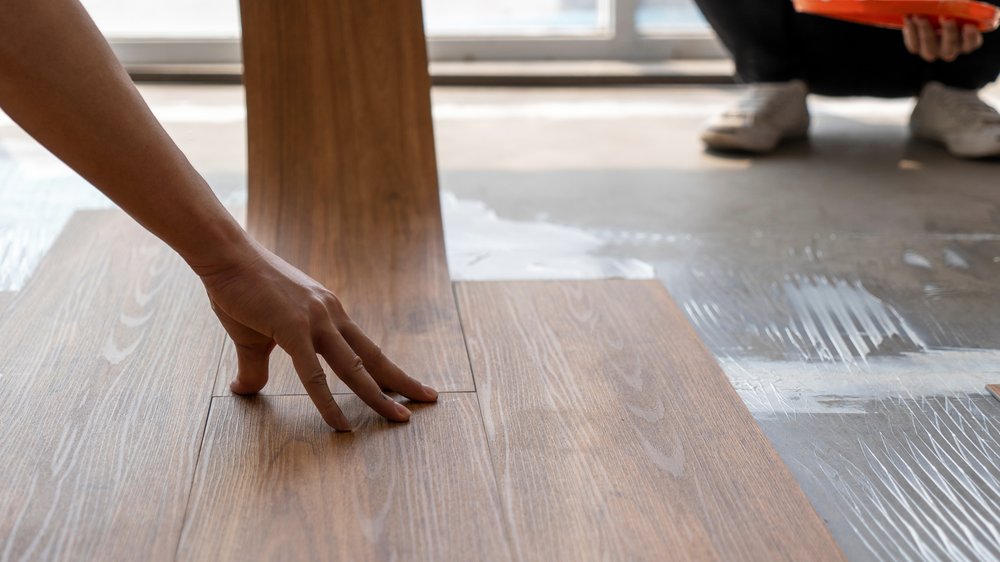
There are multiple great alternatives to hardwood floors. The most popular options are vinyl plank flooring and engineered hardwood flooring. These two alternatives will save you money and can frequently be better choices than hardwood. However, both luxury vinyl and engineered hardwood have pros and cons.
Luxury Vinyl Plank Flooring
Luxury Vinyl Plank Flooring is an excellent option for many reasons. LVP flooring is waterproof. They are the most waterproof flooring you can buy. A piece of LVP can be completely soaked in water, then dried off, and you wouldn’t be able to tell the difference. This is one of the most significant selling points for the product. Another pro of LVP is its durability. Since the flooring pieces aren’t actually made of wood but rather something much tougher, they make great floors for rough-and-tumble lifestyles. In areas with lots of traffic or furniture that moves, it’s hard to beat VLP, especially for the money. Finally, they come in many styles at many different price points. This gives homeowners many options to choose from at whatever their budget may be.
Even with the steep rise in the popularity of luxury vinyl flooring, there are a few negatives to consider. First off, luxury vinyl ultimately looks better than natural hardwoods. The technology has grown over the years, but even the most expensive vinyl can never look as good as natural wood. This difference can be felt when walking in socks or bare feet. Although it may look like wood, it does not feel like wood. Another con of all vinyl floors is that they cannot be refinished. Unlike hardwood or engineered hardwood, there is no way to sand down the floors to the wood and refinish them for a brand-new look. Finally, some types of luxury vinyl plank flooring are designed to be glued down rather than snapped in or floated. This makes it difficult if you ever need to replace any or all of your flooring.
Engineered Hardwood Flooring
Engineered hardwood flooring truly is a genius product. The flooring pieces are made chiefly of pressed wood or some other inexpensive but sturdy wood product. A thin cut of genuine hardwood is then attached to the top of the wood plank, giving the exposed side of the floor a piece of hardwood floor. This hardwood exterior cam then stained and finished like an ordinary piece of hardwood. However, many types of engineered hardwood come pre-stained and finished to reduce the total cost to the consumer. This ability to refinish and repair damaged pieces of engineered hardwood is a significant benefit when choosing between flooring types. Another pro for engineered hardwoods is the added level of luxury you can get for a fraction of the price compared to traditional hardwoods. However, there are some cons to engineered hardwoods.
Engineered hardwoods are not waterproof. They are less waterproof than regular hardwoods as the pressed wood under the hardwood veneer is more susceptible to water damage. They are also harder to repair than typical hardwood floors, so they will usually always need to be replaced if damaged. Finally, they are weaker than both vinyl and genuine hardwood floors. These factors should be considered when choosing engineered hardwood floors.
Whether you choose luxury vinyl plank floors or engineered hardwood flooring, both are truly great investments. These two products have made huge improvements even up to a few years ago. Many people choose these two products over traditional hardwood floors simply because they perform so well and are loved by so many. Both luxury vinyl floors and engineered hardwood are vast and sometimes confusing markets. If you live in New York or Florida, we would love to help you choose the brands and styles that make the most sense for you. Please reach out to us anytime for any of your flooring needs.
What Type Of Finish Does My Hardwood Have?
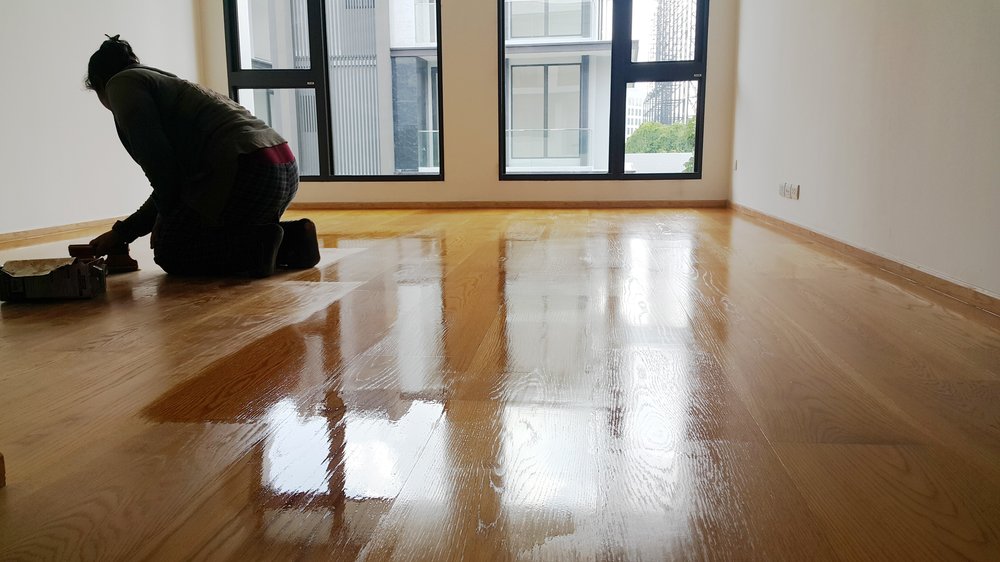
If you’re about to start a project on your hardwood floors and are wondering how they were previously finished, this article is for you.
There are two very common ways hardwood floors are finished. Figuring out how your hardwood floors have been finished is vital before you do any work on the floors themselves. The floor’s finishing will significantly impact how you approach your project. Here are the three most common types of hardwood floor finishes.
Polyurethane
Polyurethane is by far the most common type of hardwood floor finishing method. Almost all new floors that are installed are finished with polyurethane. Polyurethane finishes can be either water-based or oil-based. Oil-based polyurethane is the industry standard. Most people prefer oil-based polyurethane because it tends to look better, and less is needed when finishing floors. However, a few wood species require water-based polyurethane, but besides these unique instances, we recommend oil-based.
You can tell you have polyurethane if a shiny, protective coating is on top of the wood that is deeply bonded with the wood. You will not be able to scrape up any top coat if you try.
Wax
Wax is less popular than polyurethane but can be found in some homes. Wax is just like it sounds. When finishing, a layer of wax is applied to the stain and wood, creating a protective, waterproof coating. Floors with wax finishings are a chore to keep up. However, wax finishing has a distinct look; some homeowners just love it!
If you can easily scrape up the top layer of your floors, you probably are working with wax. The wax in the corners of the rooms will be the easiest to recognize and scrape up. Lots of very old wood floors were sealed with wax.
Before starting any project, take the time to research how your floors have been finished. In most cases, if your floors were finished a certain way, you will need to use the same product. Otherwise, you will have to strip the floors down to the raw wood and start over. This is a common practice when a homeowner wants to change the color or style of the way a floor was stained.
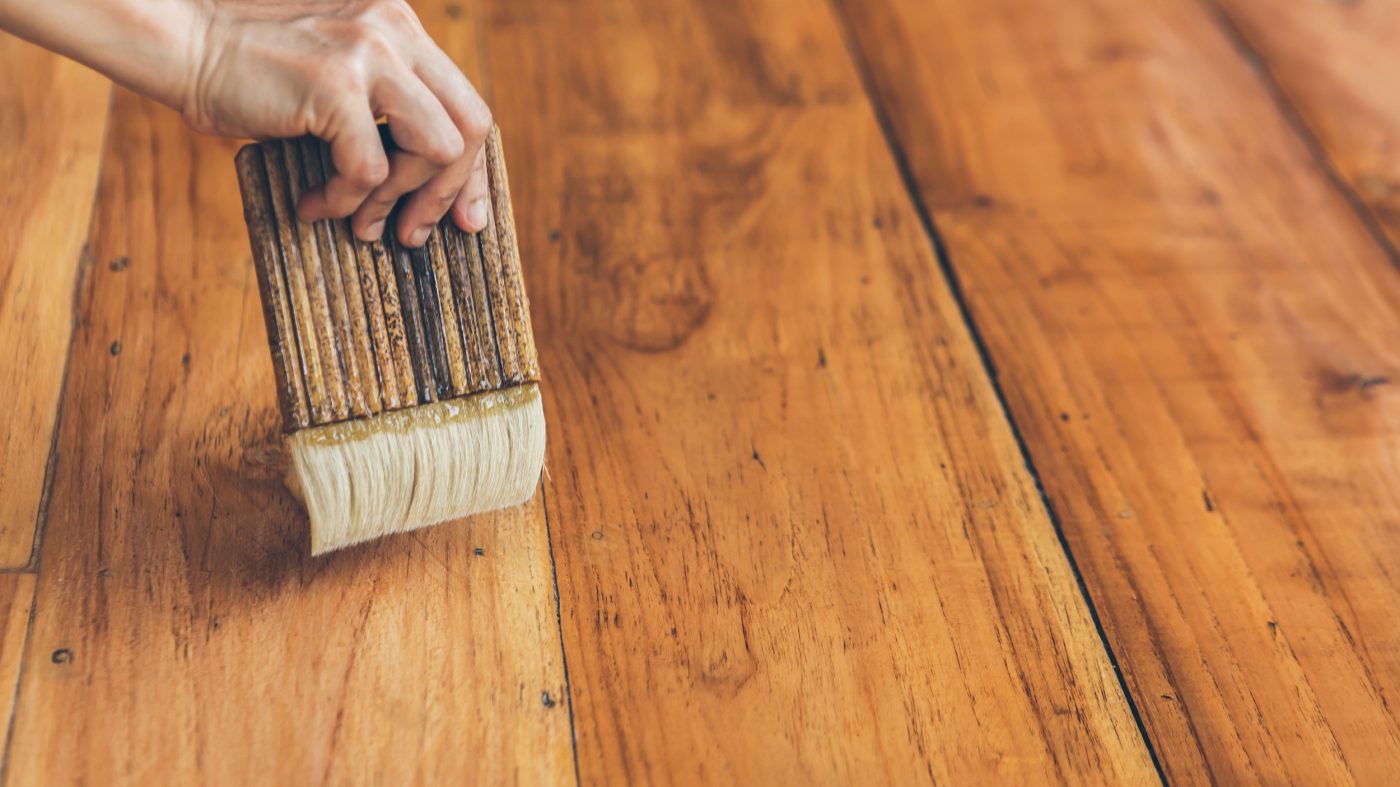
Buffing, sanding, and repairing hardwood floors can be done without professional help, but often the projects are out of the scope of most homeowners. Make sure you get your facts straight before starting a large project like this, as things can quickly become very expensive and time-consuming. We suggest talking to a hardwood flooring specialist before projects like buffing or refinishing your floors. We would love to help you!
If you are in New York or Florida, we would love to help you with any of your hardwood flooring issues. Call us today!
How To Care For Hardwood Floors In The Winter
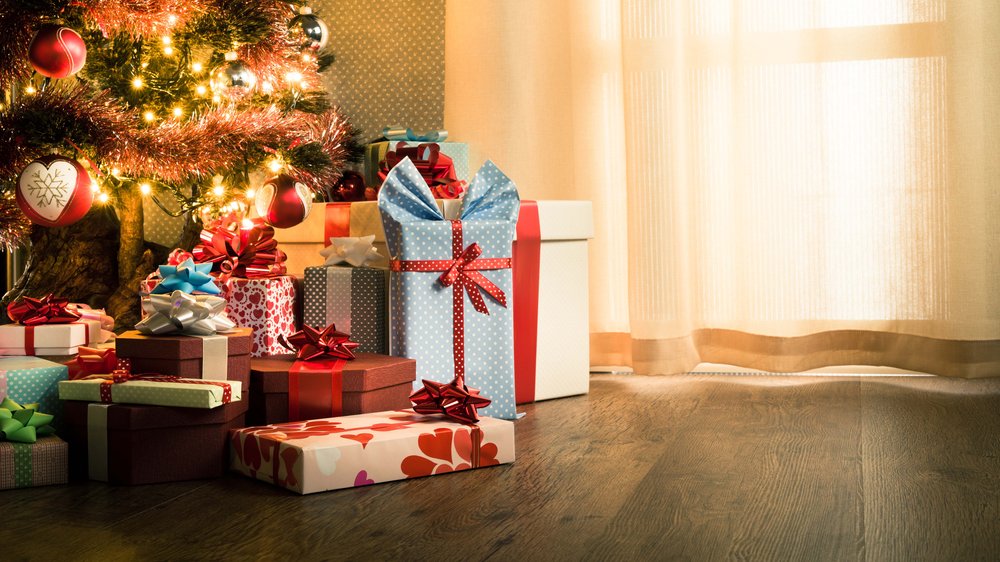
Hardwood floors are beautiful additions to any home or business. However, they also can add durable and sturdy benefits as floors in high-traffic areas. Traditionally, the winter months are the most demanding on hardwood floors. So let’s talk about how to best care for your hardwoods during the winter months and things to consider.
Water
Snow falls in many areas of the country where hardwood floors are popular. So, just because you live in an area that gets snow doesn’t mean you shouldn’t have hardwood floors. Hardwood floors do very well in regions that receive large amounts of snow. Here are a few things to consider when owning hardwoods in snow.
In high-traffic areas, tracking how much water and ice get brought onto your hardwood floors is sometimes impossible. This can be easier to keep up with in a home, where you can ask people to take off their winter boots or snow-covered. But things get even more tricky if you own a business or have hardwoods in a public space.
Water that melts from shoes or boots can wreak havoc on hardwood floors. However, you should be OK with using basic waterproof mats and mopping. Hardwood floors have been stained and sealed with a waterproof solution, so there should be no issues as long as the water isn’t allowed to sit on the floors for too long.

Salt, Mud, And Dirt
The salt, mud, and dirt tracked into the house during winter months are more harmful to your floors than snow. The salt and debris will not only discolor and stain your floors, but they will quickly begin to scratch your hardwoods if not cleaned up quickly. A good vacuum is the best way to take care of the mess that can easily get tracked into a house during winter months. If it is a wet/dry vacuum, even better! To be able to get up the water and the debris is the key to keeping your floors winter-proof.
Before heading into the winter months, make sure your floors are ready. If you see unfinished or places on your floors where the finishing has worn off, you should get them checked out and refinished before the winter is upon you!
Why Does My Floor Have Large Gaps In It??
As the weather outside gets colder, the thermostats indoors get turned up. During the winter, hardwood floors are subjected to heaters and furnaces that keep things warm. Whether hardwood floors are installed in a home or business, they typically react to a heated environment.
A byproduct of indoor heating is that they tend to dry out the air of the rooms that are heated. As a result, access humidity evaporates from indoor heaters, affecting hardwood floors. The most typical reaction for hardwood floors that have been “dehumidified” will be to shrink in size. This can be alarming to notice when all your hardwood floors shift in size and cracks form between boards that never existed before.
For most situations, the small amount of shrinking that happens to hardwoods during the winter is normal and won’t damage the floors. However, if you’re concerned or worried about your floors shrinking, you could use a humidifier to restore moisture to the environment.
Remember, seeing cracks and spaces between boards is normal. However, if you see anything besides this, it would be wise to call a flooring specialist immediately. Unfinished floors can take a beating during the winter months, resulting in costly repairs.
Affordable Ways To Upgrade To Hardwood Floors
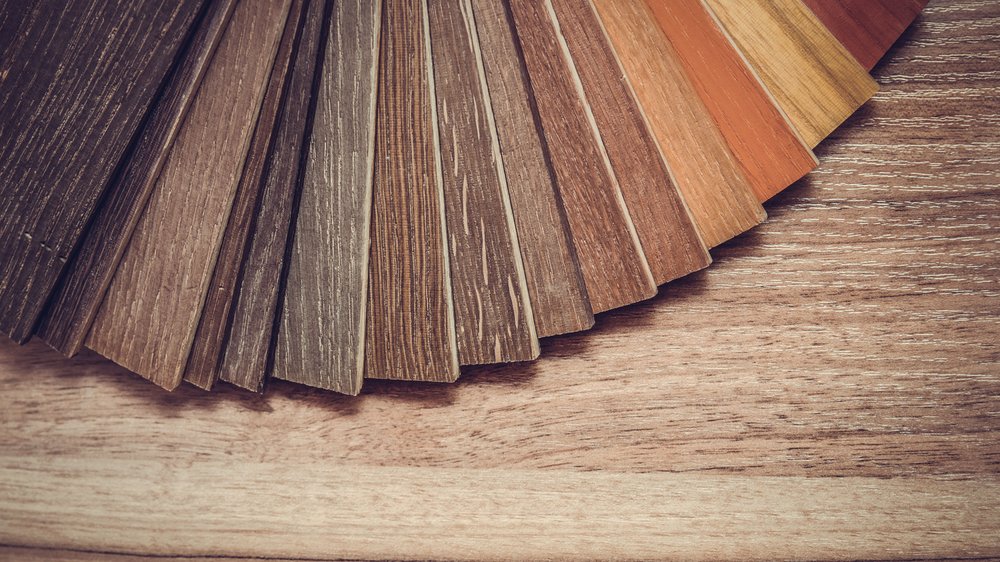
Does your home have old carpet, or do you have a gutted fixer-upper needing an affordable floor fix? Flooring takes a large part of the renovation budget for any home or business, costing upwards of $6 to $18 per square foot, including labor costs generally. Hardwood floors are a staple luxury that many consumers crave. With their high durability and style, hardwood floors are typically one of the first things that should be upgraded in a home.
Here are the three most affordable ways to upgrade to hardwood floors.

Option 1: DIY
If you are physically able and willing to do the work, you can reduce the cost of hardwoods by half. Yes, that’s correct. The labor cost to install most hardwood floors is typically more than the floors’ price.
Option 2: Material selection
If you want the look of hardwood but not necessarily the expense, reconsider the material. Luckily, there are several budget-altering adjustments that can be made by selecting a thinner, lower-grade species. Frequently, more affordable types of wood can be very similar in appearance.
Using engineered hardwood flooring is a popular way to get natural hardwood floors for much less money. This material is a hardwood veneer attached to plywood or pressed wood. Installing engineered hardwoods can be an easy DIY install, depending on your skill level and access to tools.
Purchasing thinner material is another way to reduce your cost. For example, using a lighter, 5/16″ board will cost less than the traditional 3/4″ hardwood materials.
Low-grade materials may be another way to save money. For example, some manufacturers produce different tiers of wood that reflect the quantity of the wood’s grain, texture, and pattern on a board.
Option 3: Plan for the finish line
If a do-it-yourself installation is something you are planning, consider the finishings before selecting your wood type. Tongue and groove wood is more practical for the everyday DIYer. You should consider using prefinished materials if you are not an expert in finishes such as polyurethane or resin. When using prefinished boards, once the last panel is in place, it’s over! If your hardwood doesn’t come finished from the factory, there is an additional process to work on after your floors are laid. This should be considered when budgeting for more affordable flooring options.
You should always reach out to a professional for an opinion on the extent of the project and the expenses required for completion. Often, budgets and expectations can be unrealistic without the help of experienced professionals. If you are in New York or Florida, we would love to help you with any of your hardwood flooring issues. Call us today!
How To Fix Squeaky Hardwood Floors

Squeaky hardwood floors can be a real nuisance! We have all been in houses that have had them, but what do you do when your home has squeaky floors? Why are my floors squeaking? Can anything be done at all? Can they be fixed, or do I have to replace them all? We will answer all these questions and more!
Why Do Floors Squeak?
Hardwood floors can be squeaky for several reasons. However, all hardwood floor squeaks have one thing in common: Movement. Hardwood floors are not designed to shift around and move when pressure is applied to them. Over time, however, certain parts of a house’s floors and foundation may shift, introducing movent to the floors. So always remember floors cannot squeak without some type of movement involved.
Wood expands and contracts depending on its environment. In warm and humid climates, wood will expand. In colder and dry climates, wood will contract. All this expanding and contracting means that the wood that makes up a house’s joists, subfloor, and even hardwoods can be prone to movement depending on the weather and seasons. For example, if you notice that most of your squeaking happens in colder months with less humidity, this might mean that the wood under the hardwood floors has contracted and created more room for your hardwood floors to move and squeak.
Another reason for squeaky floors could be joist or subfloor problems. Joists and subfloors make up the structure that supports the hardwood flooring that gets installed on top of it. If joists lose their integrity, the entire floor structure can become loose and saggy, creating lots of space for your floors to move and squeak. Likewise, squeaking may also occur if there is an issue with the sub-flooring that lives underneath the hardwoods.
Fixing Squeaky Floors
Fixing squeaky hardwood floors can usually be done relatively easily, as long as they are no serious issues to the foundation of your house. Unfortunately, squeaky floors caused by broken or damaged floor joists can be challenging and are typically outside most DIYers’ scope. However, if your flooring joists aren’t damaged or need repairs, most squeaky floors can be fixed without spending too much time and money on them.
One of the first ways to treat squeaky floors is by screwing the subfloors into the flooring joists for a tighter connection. Screws can be added to the sup flooring and then into the joists. You will need to remove the section of hardwood flooring and then insert the screws directly into the subfloor. Screws can also be added from underneath the joist and into the subfloor. Coming from the bottom up is a much more difficult fix, but it can often be what is needed to fix a squeak completely.
Glue and shims can also be great ways to fix squeaks. By adding shims and taking out gaps in the floor, lots of squeaks can be eliminated. Similarly to adding screws from the top down, adding wood glue to better secure the subfloor to the floor joists is also an effective way to get rid of squeaks.
All of these fixes require a homeowner to remove multiple hardwood flooring planks from a section of floor space. This can sometimes be a job that a motivated homeowner can accomplish. However, hardwood flooring can be permanently damaged if not taken apart and put back together correctly. Therefore, we suggest consulting a flooring specialist before potentially damaging your hardwood floors.
We hope we have encouraged you if you have squeaks in your hardwood floors. Getting rid of squeaks isn’t typically an extensive or expensive fix, but as we mentioned, it can often be outside the scope of many DIYers. If you would like a free consultation about your squeaky hardwood floors, please get in touch with one of our flooring specialists today!
